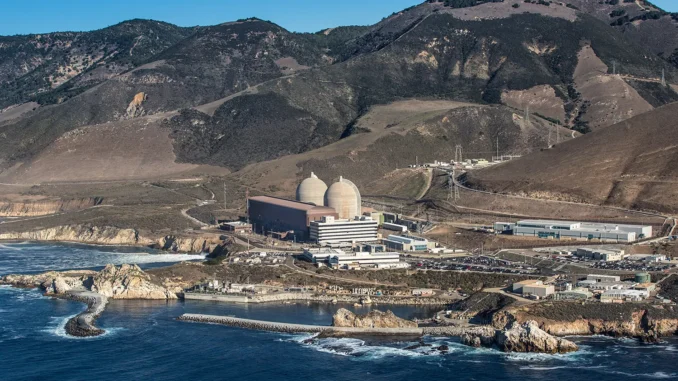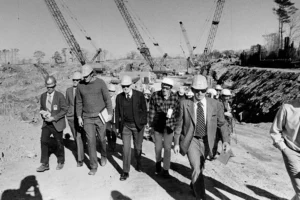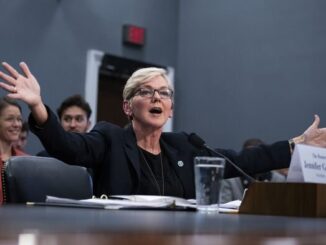
For anyone hoping to reboot the nuclear power sector as a source of zero-carbon energy in the age of climate change, the news has not been good. On Feb. 28, the staff of the U.S. Nuclear Regulatory Commission (NRC) forwarded a proposed licensing framework for next-generation reactors to the agency’s five politically appointed commissioners. That proposal came little more than a year after the NRC summarily rejected Oklo Power’s license application for its Aurora reactor. The application was the first attempt to obtain a license to operate an advanced nuclear reactor in the United States.
The new rules, mandated by the U.S. Congress, were supposed to provide a modern, streamlined licensing process for the new small reactors in advanced stages of development by multiple U.S. and international companies. Instead, the NRC staff simply cut and pasted the existing rules for large conventional reactors into a mammoth 1,200-page regulation for new reactor types.
These developments are a shock for anyone counting on a nuclear revival to cut climate emissions. Absent substantial regulatory reform, the future of nuclear energy in the United States will look very much like the past. Licensing of advanced reactors will proceed in much the same way it has for conventional reactors for decades: slowly, expensively, and with an excess of precaution so extreme that observers have long quipped that the NRC’s view of nuclear safety is that the safest reactor is one that will never be built.
The new framework will have profound consequences for efforts to address climate change. As Biden administration climate czar John Kerry rightly put it: “We don’t get to net zero by 2050 without nuclear power in the mix.” But the NRC’s influence over the future of nuclear energy will likely extend well beyond U.S. borders. Not only are many other countries counting on U.S. technology to meet their own climate and energy security objectives, but, for better or worse, they also view NRC licensing as the regulatory gold standard.
For this reason, global progress in lowering carbon emissions may ultimately be determined not by fossil fuel companies, climate activists, or elected officials, but by an insular and deeply conservative regulatory agency. The NRC has long presided over the decline of the legacy nuclear industry. Now, it proposes to apply the same highly restrictive practices to the next generation of reactors that policy-makers around the world are counting on to deliver a future of abundant clean energy.

Nascent efforts to commercialize advanced reactors highlight the vast gulf between how nuclear energy is regulated and its actual risks to the public. Nuclear regulation has always been predicated on the notion that the technology is exceptionally dangerous. The actual track record of civilian nuclear energy, however, suggests the opposite.
For more than 60 years, nuclear energy has provided a substantial share of the world’s electricity—with virtually no body count to show for it. Megawatt-hour for megawatt-hour, nuclear power has proven to be far safer than fossil fuels and at least as safe as wind and solar, which result in occasional fatalities during installation and maintenance. Well-documented nuclear safety data accounts not only for normal operations of the plants but accidents as well, including the two worst disasters in the history of civilian nuclear energy: the meltdowns at Chernobyl and Fukushima.
These two accidents were truly exceptional, worst-case events. In 2011, the Fukushima Daiichi reactors on the coast of Japan were struck by a disaster of almost biblical proportions. First, one of the strongest earthquakes ever recorded shook the region. Then a series of tsunami waves, some well over 100 feet high, swept across the coastal plain and knocked out the power supply to the reactors’ cooling system.
In 1986, at the Chernobyl plant in what is now Ukraine, Soviet authorities managed a trifecta of shocking negligence: They chose a reactor design known to be prone to a runaway reaction, built it without a containment system to keep radiation from spreading widely in case of accident, and neglected to take simple protective actions after the accident that could have mitigated the public health consequences.
And yet, contrary to popular media treatments of those events, such as HBO’s eponymous miniseries about Chernobyl, neither catastrophe turned out to be all that catastrophic. At Chernobyl, about 50 people involved in the immediate response to the disaster died from acute exposure to radiation. Since then, public health authorities have serially downgraded their projections of mortality associated with radiation exposure from the accident.
Two decades ago, the World Health Organization expected 4,000 excess long-term cancer deaths from radiation exposure at Chernobyl, mostly from thyroid cancers. By 2008, the United Nations Scientific Committee on the Effects of Atomic Radiation said it had found no evidence of any measurable increase in cancer risk among the general population.
Left: A rescue worker sets a flag signaling radioactivity in front of the Chernobyl nuclear power plant during a drill organized by Ukraine’s emergency ministry on Nov. 8, 2006. SERGEI SUPINSKY/AFP VIA GETTY IMAGES Right: The remnants of beds are seen in an abandoned preschool in the town of Pripyat near Chernobyl, Ukraine, on Jan. 25, 2006.
In the aftermath of the Fukushima meltdown, public health authorities have reached similar conclusions. The United Nations, U.S. Nuclear Regulatory Commission, U.S. Environmental Protection Agency, and Japanese government have all concluded that excess deaths due to radiation exposure from the accident are unlikely.
Together with a growing body of evidence from long-term radiation studies, the aftermaths of the Chernobyl and Fukushima accidents have forced the public health community to reconsider the risks of low-dose radiation from nuclear accidents. That does not mean there are no risks associated with radiation exposure, particularly at high doses. But low-dose radiation—the primary way that a nuclear accident affects the public—is now broadly considered a well-understood, garden-variety environmental health risk.
That insight, however, has yet to penetrate the concrete walls of the NRC’s bunker-like building on the outskirts of Washington, where the world’s most influential nuclear regulator continues to treat low-dose radiation as a catastrophic risk to public health.
The view from an observatory room shows reactor buildings and storage tanks for contaminated water at the Fukushima Daiichi nuclear power plant in Japan on Jan. 31, 2018. BEHROUZ MEHRI/AFP VIA GETTY IMAGES
Nuclear energy’s remarkable safety record over many decades is, of course, due in no small part to regulations that ensure radiation exposure to the public remains low, even in the event of a major accident such as the one that occurred at Fukushima.
Much of the cost of designing, licensing, building, and operating a conventional nuclear reactor is associated with the massive containment structures; multiple backup cooling systems; large, high-security exclusion zones; and other safety measures required by regulation to protect the public. These measures have played a significant role in raising the cost of building nuclear reactors. They have also, without question, helped ensure that nuclear power plants rarely expose the public to any meaningful level of radiation from either normal operations or accidents.
Today, the critical question facing the world’s nuclear regulators as they prepare to license advanced reactors is what rules are necessary to ensure public safety when the new technology can’t produce remotely as much radiation exposure as conventional reactors.
Due to fundamental properties associated with their designs, most advanced nuclear reactors are inherently much safer than conventional reactors. They are smaller and contain far less fissile material. They utilize fuels that are less prone to runaway reactions and less capable of melting down. And they are not cooled by water, which means they do not require any mechanical pumping of coolant through the reactor at high pressure.
How much safer are they? For small advanced designs such as Oklo’s Aurora reactor, a worst-case accident—defined by current NRC policy as the worst possible accident with a chance of happening once every 100,000 operating years—would result in a radiation dose to people living in the vicinity of the plant equivalent to about one-fifth of what one could get from a CT scan. Compared to the NRC’s current limit for potential radiation doses from conventional reactor accidents, the exposure would be lower by a factor of 100.
Exposing the public to a fraction of the radiation they receive from a routine medical procedure in the event of a once-in-100,000-years accident might seem like an acceptably strict standard to enforce upon the nascent advanced nuclear industry—particularly when compared to the well-established public health consequences of fossil-fuel combustion. But the longstanding position of the NRC is that no level of public health risk associated with the operation of any nuclear reactor is acceptable.
In pursuit of the holy grail of zero risk—an expectation that no other energy source must meet—the NRC uses statistical models that assume latent cancer risk even from infinitesimally low levels of radiation exposure, far below anything that could ever be observed in an exposed population. Based on these models, the NRC has adopted standards that give its staff carte blanche to demand ever more stringent safety equipment and operational routines despite no evidence of any measurable public health benefit from increased caution.
That bottomless quest to eliminate all risk, even when it is entirely theoretical, is reflected in the rules the NRC has now proposed for advanced reactors. In one particularly bizarre instance, the NRC proposes a method for calculating public health risk associated with a worst-case accident that is literally impossible, requiring a license applicant to assume a worst-case accident occurs every year for 40 years and that the exposed population never moves or dies of any other cause (including old age) over a period of 50 years.
The new rules, if adopted, would negate many of the benefits that have led the nuclear industry and U.S. policymakers to turn to advanced reactors in the first place. The attraction of advanced reactors, after all, is that they can achieve higher levels of safety with far simpler designs, obviating the need for costly, complex features such as massive containment structures and multiple redundant pressurized cooling systems. The NRC’s proposed approach to licensing would foreclose much of the new industry’s promise.
Anti-nuclear protesters stage a sit-in on the roadway at the Diablo Canyon nuclear facility in San Luis Obispo, California, on June 30, 1979.
While the new advanced reactor rules have yet to be approved and implemented, Oklo’s journey through the NRC’s Kafkaesque bureaucracy offers a cautionary tale for anyone who imagines that it might be possible to launch an innovative advanced nuclear industry without far-reaching changes at the agency.
From its origins as a graduate project at the Massachusetts Institute of Technology, the Aurora reactor was designed to be easy to license, commercialize, and scale up. As a so-called micro-reactor, it would produce about 1.5 megawatts of electricity, making it about 600 times smaller than a conventional reactor. The initial market was off-grid communities in remote areas, where electricity often costs 10 times more to generate than it does in locations connected to the grid. Oklo’s plan was to get to market quickly; manufacture lots of very small reactors to establish supply chains, improve production methods, and drive down costs; and then scale up to serve more competitive markets. Other major players in the advanced nuclear industry, such as Bill Gates’ TerraPower, planned to have their first reactors in operation by the end of the decade. Silicon Valley-based Oklo, by contrast, planned to build its first reactor in 2024.
It was an audacious plan at start-up speed, just the sort of thing that most advocates of a rapid clean energy transition believe is necessary. But Oklo’s strategy was largely predicated on the idea that the company would be able to convince the NRC that most of the cumbersome, expensive licensing rules designed for large, conventional reactors need not apply to its micro-reactor. On its face, the premise seemed reasonable: Why shouldn’t the NRC adapt its licensing requirements to accommodate a technology that simply cannot produce anything remotely approaching the radiological risk associated with much larger, older reactor types?
But things quickly went awry.
For instance, Oklo wanted to use an alternative method for assessing a worst-case accident. Under the existing rules, the company was required to use an extremely complicated safety model called a probabilistic risk assessment, which basically reviews every single nut, bolt, pump, and valve in a reactor, looking for every possible pathway where a series of compounding failures of components and systems might result in a catastrophic event.
This kind of assessment can be a sensible approach for highly complex systems such as large pressurized water reactors, which are surrounded by miles of piping, clad in acres of concrete containment structures, and dependent on multiple redundant cooling systems. It is the same approach used by the U.S. Federal Aviation Administration to license large commercial aircraft in order to ensure that a cascading series of small failures won’t lead to a plane crash. But using that method to conduct the safety analysis for the Aurora reactor—which has no moving parts or mechanical systems—would be like evaluating the safety of a hang glider using regulations for a Boeing 747.
Nonetheless, the NRC insisted that the rules required Oklo to conduct the full assessment and rejected the company’s proposed alternative analysis, which would have demonstrated that the radioactive core of the reactor was so small and stable that it could not, even in a worst-case accident, produce significant radiological exposure to the public.
Similar conflicts appear again and again in the reams of public documents associated with Oklo’s license application. The company and NRC repeatedly found themselves at loggerheads, caught between the agency’s long-standing practices for evaluating large reactor safety and Oklo’s view of what sort of approach was appropriate to the tiny reactor it was seeking to build.
The stakes for Oklo went well beyond the cost, complexity, and time it would take to receive regulatory approval. The reason the company wanted to avoid the long-standing regulatory requirements for large reactors was to keep as much of the reactor design and physical plant as possible out of the safety analysis, because anything included in the safety analysis would be subject to much higher regulatory scrutiny as the company moved forward with manufacturing.
That would create major problems for Oklo down the line. Much of the promise of small modular reactors has always been that they would facilitate much greater process innovation and technological learning—and hence ensure cost reductions as production scales up. That requires the flexibility to adjust supply chains, reconfigure components, and modify manufacturing and assembly processes. In contrast, anything included in the safety analysis would require a costly and time-consuming license amendment to change.
Even under current rules, the NRC staff had the flexibility to allow the kind of risk assessment Oklo was proposing. But doing so would have diverged from decades of regulatory practice, establishing a precedent that other advanced reactor developers—many of whom are pursuing similar small, low-risk technologies—might have followed.
With its ruling on Oklo’s license application, the NRC left little question about how it would approach the nascent advanced nuclear industry. Any remaining doubt was erased when the agency released the proposed framework for advanced reactors this month. The NRC staff had rejected many of Oklo’s proposals on procedural, not substantive, grounds, inaccurately claiming that existing regulations foreclosed any alternative approach. But the new proposed framework confirmed that the agency has little interest in modifying its regulatory practices—or the out-of-date public health assumptions that underpin them—to accommodate a new generation of innovative nuclear technologies.
Anti-nuclear power protesters hold a banner on Three Mile Island near Harrisburg, Pennsylvania, in 1979.
The urgent need to reform the NRC has long been undermined by a myth about the agency’s establishment. Before the NRC began operations in 1975, the U.S. Atomic Energy Commission was responsible for both promoting nuclear energy and regulating it. That dual role, according to some, compromised nuclear safety. The NRC was therefore created, the story goes, with the sole responsibility of regulating nuclear energy without any consideration of its benefits.
There is, in fact, no language in the U.S. Energy Reorganization Act, which created the NRC, that mandates this singular focus. On the contrary, the law’s stipulated purpose was to serve a variety of national priorities, including energy security, economic productivity, environmental protection, and public health. Nowhere in the act or subsequent Congressional legislation is there any suggestion that the NRC should regulate the risks associated with the operation of nuclear power plants without any consideration of reactors’ social, economic, or environmental benefits.
Nonetheless, from its inception, the NRC has interpreted its mandate in this way. So narrowly does the agency see its focus that it refuses to consider even the public health benefits of displacing fossil fuels when assessing the risks associated with licensing and operating commercial nuclear plants.
No other safety regulator in the world approaches public health and safety in this way. By fetishizing reactor safety without any consideration of the risks associated with the rest of the electricity system, the NRC has dramatically and unconscionably increased the public health burden associated with U.S. energy production.
The U.S. electricity system remains dominated by fossil fuels, causing air pollution that kills hundreds of thousands of Americans every year. In 2013, then-NASA scientists Pushker Kharecha and James E. Hansen estimated that U.S. use of domestic nuclear power plants (most of which were licensed prior to the NRC’s creation) had already avoided more than 500,000 excess deaths from air pollution since 1980 and would prevent 1 million more by 2050. Of course, that calculation does not account for deaths caused by additional air pollution after the premature closure of nuclear power plants; nor did it consider the impact of plants that were never built following the 1979 Three Mile Island accident, which galvanized political opposition to nuclear power in the United States.
In the name of protecting the public from exposure to extremely low levels of radiation, the NRC has ignored the substantial public health risks associated with not building nuclear power plants, including hundreds of thousands of avoidable fossil fuel-caused deaths in the United States over the last four decades. Despite the overwhelming negative public health consequences of limiting the use of nuclear energy when fossil fuels are used instead, regulators in the United States and many other countries still treat nuclear energy as the most dangerous source of energy—not the safest. The resulting regulatory standards and practices create enormous obstacles to nuclear innovation and the deployment of affordable nuclear energy at scales that could displace fossil fuels and prevent millions of deaths around the world, as well as play a critical role in addressing climate change.
It is encouraging that recent years have seen a sea change in opinion about nuclear energy among U.S. Democrats and liberal parties in other countries, where anti-nuclear sentiment has long dominated. Many policy-makers supporting stricter climate policies have now backed public investments in nuclear innovation, the inclusion of nuclear energy in clean energy standards, and programs to keep existing nuclear plants open. But the hangover from the previous generation’s anti-nuclear activism continues to undermine efforts to revitalize the nuclear industry. Until policy-makers across the West are willing to follow the science, reassess the public health evidence that underpins nuclear regulation, and reset the regulatory frameworks that govern the use of the technology, the substantial environmental, public health, and energy security benefits nuclear power can deliver are unlikely to be realized.








